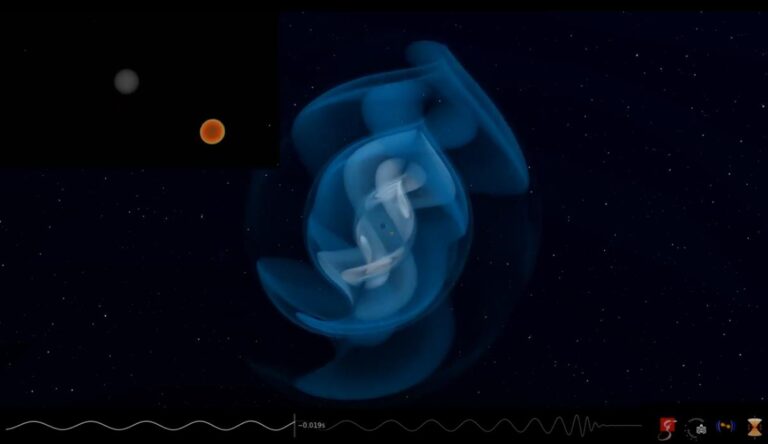电脑模拟: 二颗黑洞合并
请参阅说明。单击视频将下载可用的最高分辨率版本。

请参阅说明。单击视频将下载可用的最高分辨率版本。

2023年6月29日 A Message from the Gravitational Universe Illustration Credit: NANOGrav Physics Frontier Center; Text: Natalia Lewandowska (SUNY Oswego) Explanation: Monitoring 68 pulsars with very large radio telescopes, the North American Nanohertz Observatory for Gravitational Waves (NANOGrav) has uncovered evidence for the gravitational wave (GW) background by carefully measuring slight shifts in the arrival times of pulses. These shifts are correlated between different pulsars in a way that indicates that they are caused by GWs. This GW background is likely due to hundreds of thousands or even millions of supermassive black hole binaries. Teams in Europe, Asia and Australia have also independently reported their results today. Previously, the LIGO and Virgo detectors have detected higher-frequency GWs from the merging of individual pairs of massive orbiting objects,…

2022年11月20日 Airglow Ripples over Tibet Image Credit & Copyright: Jeff Dai Explanation: Why would the sky look like a giant target? Airglow. Following a giant thunderstorm over Bangladesh in late April, giant circular ripples of glowing air appeared over Tibet, China, as pictured here. The unusual pattern is created by atmospheric gravity waves, waves of alternating air pressure that can grow with height as the air thins, in this case about 90-kilometers up. Unlike auroras powered by collisions with energetic charged particles and seen at high latitudes, airglow is due to chemiluminescence, the production of light in a chemical reaction. More typically seen near the horizon, airglow keeps the night sky from ever being completely dark. Tomorrow’s picture: butterfly sky 西藏上空的气辉涟漪 图像提供与版权: Jeff Dai(戴建峰) 说明:…

2022年6月5日 Two Black Holes Dancing in 3C 75 Image Credit: X-Ray: NASA/CXC/D. Hudson, T. Reiprich et al. (AIfA); Radio: NRAO/VLA/ NRL Explanation: What’s happening at the center of active galaxy 3C 75? The two bright sources at the center of this composite x-ray (blue)/ radio (pink) image are co-orbiting supermassive black holes powering the giant radio source 3C 75. Surrounded by multimillion degree x-ray emitting gas, and blasting out jets of relativistic particles the supermassive black holes are separated by 25,000 light-years. At the cores of two merging galaxies in the Abell 400 galaxy cluster they are some 300 million light-years away. Astronomers conclude that these two supermassive black holes are bound together by gravity in a binary system in part because the jets’ consistent…

2021年12月07日 Ninety Gravitational Wave Spectrograms and Counting Image Credit: NSF, LIGO, VIRGO, KAGRA, Georgia Tech, Vanderbilt U.; Graphic: Sudarshan Ghonge & Karan Jani Explanation: Every time two massive black holes collide, a loud chirping sound is broadcast out into the universe in gravitational waves. Humanity has only had the technology to hear these unusual chirps for the past seven years, but since then we have heard about 90 — during the first three observing runs. Featured above are the spectrograms — plots of gravitational-wave frequency versus time — of these 90 as detected by the giant detectors of LIGO (in the USA), VIRGO (in Europe), and KAGRA (in Japan). The more energy received on Earth from a collision, the brighter it appears on the graphic….

2021年7月14日 GW200115: Simulation of a Black Hole Merging with a Neutron Star Video Credit: Simulation: S.V. Chaurasia (Stockholm U.), T. Dietrich (Potsdam U. & MPIGP); Visualization: T. Dietrich (Potsdam U. & MPIGP), N. Fischer, S. Ossokine, H. Pfeiffer (MPIGP) Explanation: What happens when a black hole destroys a neutron star? Analyses indicate that just such an event created gravitational wave event GW200115, detected in 2020 January by LIGO and Virgo observatories. To better understand the unusual event, the featured visualization was created from a computer simulation. The visualization video starts with the black hole (about 6 times the Sun’s mass) and neutron star (about 1.5 times the Sun’s mass) circling each other, together emitting an increasing amount of gravitational radiation. The picturesque pattern of gravitational…

2020年11月4日 Fifty Gravitational Wave Events Illustrated Image Credit: LIGO Virgo Collaborations, Frank Elavsky, Aaron Geller, Northwestern U. Explanation: Over fifty gravitational wave events have now been detected. These events mark the distant, violent collisions of two black holes, a black hole and a neutron star, or two neutron stars. Most of the 50 events were detected in 2019 by the LIGO gravitational wave detectors in the USA and the VIRGO detector in Europe. In the featured illustration summarizing the masses of the first 50 events, blue dots indicate higher-mass black holes while orange dots denote lower-mass neutron stars. Astrophysicists are currently uncertain, though, about the nature of events marked in white involving masses that appear to be in the middle — between two and five…

2020年9月8日 GW190521: Unexpected Black Holes Collide Illustration Credit: Raúl Rubio (Virgo Valencia Group, The Virgo Collaboration) Explanation: How do black holes like this form? The two black holes that spiraled together to produce the gravitational wave event GW190521 were not only the most massive black holes ever seen by LIGO and VIRGO so far, their masses — 66 and 85 solar masses — were unprecedented and unexpected. Lower mass black holes, below about 65 solar masses are known to form in supernova explosions. Conversely, higher mass black holes, above about 135 solar masses, are thought to be created by very massive stars imploding after they use up their weight-bearing nuclear-fusion-producing elements. How such intermediate mass black holes came to exist is yet unknown, although one…

合并后的黑洞 版权:ESA 当两个超大质量黑洞(supermassive black hole)相撞时,会发生什么?在不久的未来,结合欧洲空间局(European Space Agency,ESA)两个任务的观测,雅典娜(Athena)和空间激光干涉仪(LISA),这一谜题就会揭晓,我们将能深入研究这样的宇宙级冲突以及其神秘莫测的后续故事。 这种黑洞之所以被称为“超大质量黑洞”,是因为它们的质量为太阳的数百万到数十亿倍,所处的位置也是宇宙中质量总和最大的那些星系中心。至今,我们都没弄清楚这些体型和密度都巨大无比的物质是如何形成的,也不知道是什么力量让其中的小小的一部分,以极高的速率吞噬周围的物质,在电磁波谱中产生大量的辐射,并将所在的宿主星系变成“活跃的星系核(galactic nucleus)”。 解决现代天体物理学中的这些开放性问题,是ESA空间科学计划未来两项任务的主要目标之一,这两项任务分别是高能天体物理高级望远镜“雅典娜”(Advanced Telescope for High-ENergy Astrophysics,Athena)和空间激光干涉仪(Laser Interferometer Space Antenna ,LISA)。 两项任务目前均处于研究阶段,计划于2030年代初期启动。 ESA的科学主任金特•哈辛格(Günther Hasinger)表示:“雅典娜和LISA都会是出类拔萃的科学任务,将在天体物理学的许多领域取得突破。”他解释说:“但是有一个尤其激动人心的实验,只能在两个任务同时运作,并运作的时间至少好几年时才能完成:通过在X射线和引力波中观察超大质量黑洞的合并,为宏大的‘宇宙电影’完成配音。” 金特对这两项任务非常看好:“凭借这一独特的机会,我们将对宇宙最迷人的现象之一进行前无古人的观察,雅典娜与LISA之间的协同合作,将大大提高两个任务的科学回报,确保欧洲在一个至关重要而新奇的研究领域的领导地位。” [rml_read_more] 探索极致宇宙的两项任务 版权:ESA – S. Poletti 雅典娜将成为有史以来最大的X射线天文台,以前所未有的准确性和纵深性,研究宇宙中一些温度最高、能量最为活跃的现象。 雅典娜任务的目的是为了回答两个基本问题:星系中心的超大质量黑洞是如何形成以及演化的;可见的“普通”物质如何与隐形的暗物质合纵连横,形成弥漫在整个宇宙中的纤细“宇宙网”的。 “雅典娜测量的黑洞数目将高达数十万个,涉及的范围从相对较近的地方到遥远的宇宙深处,对这些黑洞周围环境中温度高达数百万度的热物质发射的X射线进行观测。”ESA的雅典娜研究科学家马泰奥•伊瓜纳齐(Matteo Guainazzi)说道,“我们对那些最遥远的黑洞尤其感兴趣,它们诞生于宇宙形成的最初几亿年里,我们希望最终能明白它们究竟是如何形成的。” 与此同时,LISA则将成为第一个引力波(gravitational wave)空间观测站。引力波是指时空结构的弯曲波动,由重力场极强的宇宙物质加速运动产生,以波的形式向外传播。而一对正在合并的黑洞,就满足产生引力波的条件。 引力波天文学的兴起只有5年左右的时间,目前的探测仅限于高频波,探测器也限制在地面上,例如美国国家科学基金会(National Science Foundation,United States)的激光干涉引力波天文台(Laser Interferometer Gravitational-wave Observatory,LIGO)和欧洲位于意大利的“室女座”干涉仪(Virgo interferometer)。这些实验能较为精确地探测到小型黑洞的合并,它们的质量大约为太阳质量的几倍到几十倍。 一对正在合并的超大质量黑洞 版权:ESA LISA将会对低频引力波进行探测,让现有的这些研究得到进一步扩展,例如在星系合并时,探测两个超大质量黑洞碰撞产生的引力波。 “LISA将会是此类任务的先行者,主要探寻的就是超大质量黑洞相撞所引发的引力波。”ESA LISA研究项目的科学家保罗•麦克纳马拉(Paul McNamara)解释说,“这是人类所知能量规模最大的事件之一,黑洞相撞释放的能量将超过任意时间下所有静止的宇宙能量。在宇宙任何地方,如果有两个超大质量黑洞合并了,LISA就能观测到这一壮观的事件。” LIGO和Vigro在2015年到2017年之间探测到了第一批引力波事件,均源于恒星级质量黑洞(stellar-mass black hole);而后,在2017年的八月,另一种来源的引力波也得到了探测,那也是人类第一次直接探测到来自双中子星合并的引力波。 相比恒星级黑洞合并不会辐射出任何形式的光,双中子星合并产生的引力波则伴随了电磁波谱的辐射,很容易通过大量的地球望远镜和空间望远镜观测到。用多信使天文学(multi-messenger astronomy)的方法,将各种类型的观测资料结合起来,科学家就能深入研究这种从未被探测过的现象。 雅典娜和LISA的强强联合,会使我们能够首次将多信使天文学应用在超大质量黑洞上。现有的模拟预测:不同于恒星级黑洞,超大质量黑洞的合并将同时发射出引力波和辐射射线。在相撞之时,两个星系的高温星际气体被相遇的两个黑洞搅动,从而引发了辐射的产生。 LISA和雅典娜的协同合作 版权:ESA – S. Poletti 在两个螺旋形黑洞最终合并的一个月前,LISA会探测它们发射出的引力波,那时,黑洞之间的距离大约有它们半径的好几倍。科学家预计,LISA能探测到宇宙中所有合并事件的一小部分,特别是距离我们几十亿光年的那些合并,合并产生的X射线会增强,让雅典娜最终能观测到。 “实际上,我们甚至都没法知道LISA探测到的第一个信号来自哪里,因为LISA是一个全天空的传感装置,相比于望远镜,它的工作原理更像是一个麦克风。”保罗解释道。 黑洞合并 版权:ESA “但是,当黑洞旋转着互相靠近时,它们的引力波信号幅度会得到增强;再加上卫星沿轨道的运动,LISA将能够逐渐提高引力波源空间位置的精度,直到两个黑洞最终合并为止。” 在合并末期的几天前,引力波数据会将事件源的位置精确到约10平方度的天空区域,大约为满月时月球面积的50倍。 这个范围还是很大,但足以能够让雅典娜着手扫描深空,寻找这种巨大冲撞事件发出的X射线。模拟表明,两个螺旋形黑洞会调节周围的气体运动,因此X射线特征可能具有与引力波信号相当的频率。 然后,就在黑洞最终合并前的几个小时,LISA可以提供关于空间位置更精确的指示,基本上与雅典娜宽视场成像仪(Wide Field Imager,WFI)的视野大小相同,因此X射线观测台可以直接指向事件源。 “在两个黑洞合为一体之前捕捉到X射线信号将会是一个巨大的挑战,但是我们非常有信心,能够在合并期间和之后成功观测到X射线。” 马泰奥解释说,“我们或许可以看到新X射线源的出现,甚至也许能目睹一个活跃星系核的诞生,还会有高能粒子流以接近光速的速度发射到新形成的黑洞之上和之外。” 当超大质量黑洞合并 版权:ESA – S. Poletti 我们从未观察到超大质量黑洞合并事件,因为到目前为止,我们并没有能达到观测条件的设备。首先,我们需要LISA来探测引力波,并告诉我们该往空中的哪个方向进行搜寻;然后,我们还需要雅典娜利用X射线对黑洞合并事件进行高精度观察,看看如此浩大的碰撞会对黑洞周围的气体产生怎样的影响。 我们完全可以用理论和模拟来预测事件的走向,但如果想要知道确切的答案,我们就需要这两个宏伟任务的协同合作。 一百年前,1919年的5月29日,在日全食期间对恒星位置的观测,给爱因斯坦广义相对论所预测的光的引力弯曲提供了第一个经验证据。 那次历史性的日食开创了地球和太空中引力实验的世纪,启发了雅典娜和LISA等任务,以及更多更令人兴奋的发现。 1919年日食的照片底片 版权:皇家天文学会(Royal Astronomical Society) 2014年,雅典娜被选为ESA宇宙视觉计划中的第二大(L2)任务,而LISA则是2017年的第三大(L3)任务。2019年的白皮书中,雅典娜-LISA的协同研究团队描述了两个任务联合执行可以进行的附加科学研究。 雅典娜由ESA主导,美国航空航天局(NASA)和日本宇宙航空研究开发机构(Japan Aerospace Exploration Agency,JAXA)做出了重要贡献。WFI由德国马克斯普朗克外星物理研究所(Max Planck Institute for extraterrestrial Physics)领导的国际财团提供,包括多个ESA成员国以及美国。 在法国国家空间研究中心(Centre National d’Etudes Spatiales,CNES)的管理下,X射线积分视场单元(X-ray Integral Field Unit,X-IFU)由法国、荷兰和意大利领导的国际财团提供,此外还包括几个ESA成员国、日本和美国。 LISA由ESA主导,NASA做出了重要贡献。 LISA背后的财团由德国马克斯普朗克引力物理研究所(Max Planck Institute for Gravitational Physics)领导,还包括多个ESA成员国和美国。 参考: http://www.esa.int/Our_Activities/Space_Science/A_unique_experiment_to_explore_black_holes